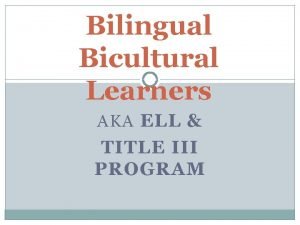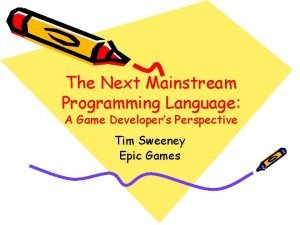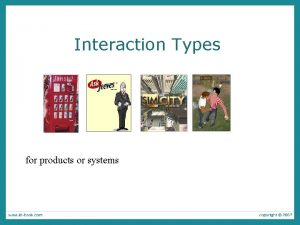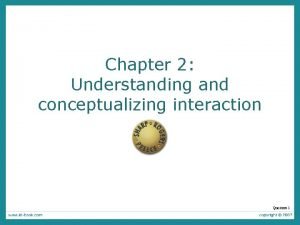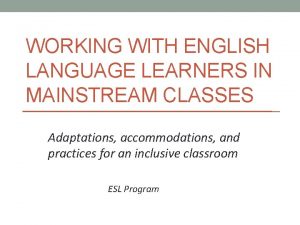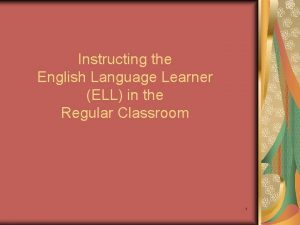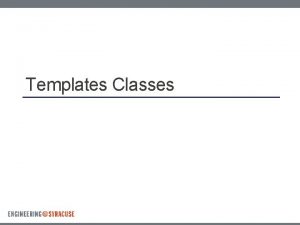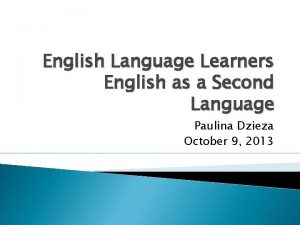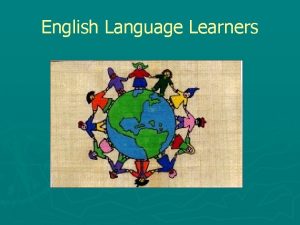Instructing English Language Learners in Mainstream Classes Answer













- Slides: 13

Instructing English Language Learners in Mainstream Classes

Answer these questions… � DON’T � What TALK…only write your responses. does ELL mean? � How does our school respond to ELL students? � What do we do to accommodate them?

Background � More English Language Learners enter our school each year � ELLs need to learn English while also existing within their cultures � ELLs also need to learn content area – leaving them to fend for themselves as long as they are not a “distraction” is not accommodating them. � Our school is not receptive to ELLs’ needs, nor are we reaching out

Through their Eyes � “It is true that I would never forget the great change of my life, the diminished occasions of intimacy. But there would also be times when I sensed the deepest truth about language and intimacy: Intimacy is not created by a particular language; it is created by intimates. ” � http: //www. youtube. com/watch? v=34 TAh. Gy g. SQI&feature=related

Through their eyes � Rodriguez identifies the change in his home, the lack of familial intimacy…What does he mean by this?

Common Barriers � Integrated Classrooms ◦ Group discussion �How do we react when ELL students enter our classrooms? �What do we do to ensure that these students are learning? �Do we focus only on English language learning? �Do we focus on content? �Do we try to engage ELLs or do we just hope they aren’t a behavioral problem?

Rationale � We need to support ELLs because… ◦ “L 2 learners should be exposed to meaningful experiences” in English from early on in their English learning (Edwards, 2011). ◦ “The acquisition of English alone in no way guarantees that L 2 students will succeed academically” (Edwards, 2011). ◦ Lau v. Nichols requires “schools to teach ELLs so that they may have a ‘meaningful opportunity to participate in the public educational program’” (Goldenberg, 2010, p. 18).

Strategies - Discussion � Think about Reading Apprenticeship training. ◦ What skills do we use to ensure reading comprehension for our English speaking students? ◦ How can we apply this to ELL students? ◦ This is NOT enough… ◦ “There are fundamental differences between literacy learning in an L 1 and in an additional language” (Allison and Harklau, 2010, p. 133). ◦ So, what now?

ESL Strategies � “Reading interventions need to be tailored for ELLs’ specific needs, such as developing cultural background knowledge, enriching and enhancing academic vocabulary, and developing a sense of academic genres” (Allison and Harklau, 2010, p. 133). � Much to discuss, but one particular focus for today…

Multimodal Presentation � What is a multimodal presentation? ◦ “Multimodal support is provided through visual (maps, diagrams, pictures), gestural and actional cues” (Sharpe, 2006, p. 211). ◦ Reading/English should be supported with multiple visual and kinesthetic modes. � Discussion ◦ How is this beneficial? ◦ Do you use various modes of presentation in your lessons? ◦ Why/why not?

Implementation � How can we do this? � Read the article on your table (each table has a different article). How do they achieve it? ◦ ◦ ◦ ◦ Scaffolding Connecting to prior knowledge Use pictures to support vocabulary Indicate text features, clues Use video to support ideas (clips…this isn’t movie day) Use hands on projects to enhance meaning Move around, don’t just sit and lecture Integrate outside materials…not just pictures in the textbook, but authentic pieces of information for the individual lesson.

Design Time � Take the remaining time to review one of your lessons and consider how to make it multimodal

References � � � Cary, S. (2007). Working with English Language Learners: Answers to Teachers’ Top Ten Questions. Portsmouth: Heinemann. Edwards, P. and Li, Guofang. (2010). Best Practices in ELL Instruction. New York: Guilford. Sharpe, T. (2006). ‘Unpacking’ Scaffolding: Identifying Discourse and Multimodal Strategies that Support Learning. Language and Education. 20. p. (211 -231). Derived from: http: //www. tandfonline. com. ezproxy. emich. edu/doi/pdf/10. 10 80/0950078060866724
 Assistive technology for english language learners
Assistive technology for english language learners English language learners
English language learners Reading strategies for english language learners
Reading strategies for english language learners Equal protection for english language learners
Equal protection for english language learners Reverse mainstream class
Reverse mainstream class Mainstream programming languages
Mainstream programming languages Mainstream flights
Mainstream flights Mainstream vs counterculture
Mainstream vs counterculture Mainstream smoke
Mainstream smoke Sidestream smoke
Sidestream smoke Instructing interaction type example
Instructing interaction type example Instructing conversing manipulating exploring
Instructing conversing manipulating exploring Soil seed sower in health education
Soil seed sower in health education It refers to the process of instructing guiding counselling
It refers to the process of instructing guiding counselling

